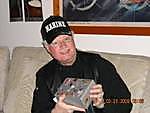Thank you Terri,
I ran accross this in some NASA documents.
". . A bewildering variety of two-seat army cooperation aircraft were designed, developed, and operated by the Germans in World War 1. Albatros, AEG, Roland, DFW, Halberstadt, AGO, Aviatik, LVG, Junkers, and Rumpler are only a few of the companies that produced army cooperation aircraft during the conflict. Some of these aircraft were designed for general-purpose reconnaissance duties, others for night bombing, and still others for the ground attack role in close cooperation with friendly ground troops. An interesting aircraft in this latter category, the Junkers J.I, is described here and is shown in figure 2.25.
The J.I biplane had a rather unusual appearance with thick, cantilever wings that were tapered in both planform and thickness ratio. Three-view drawings show that the aircraft was really a sesquiplane, with the bottom wing much smaller in span and chord than the upper wing. The small-chord lower wing, together with its position below the lower surface of the fuselage, afforded good downward visibility for the pilot in the front cockpit and the observer in the rear. The wings were connected to each other and to the fuselage by a rather complex cabane-strut arrangement. No interplane struts were used between the wings. Like all Junkers aircraft, the J.1 incorporated an all-metal structure. The wing was composed of 0.08-inch corrugated aluminum alloy skin riveted to an internal framework of aluminum alloy tubing. The engine and crew were encased in an armored shell formed from 0.2inch sheet steel. The aft portion of the fuselage consisted of a metal alloy frame covered with fabric in early models but with sheet metal in later versions. Power was provided by a six-cylinder, water-cooled, Benz Bz.IV engine of 200 horsepower. The aircraft was usually armed with two fixed, synchronized machine guns firing between the propeller blades and with a single flexible gun for use by the observer. Two downward-firing guns were sometimes installed for the observer, but the difficulty of aiming these guns from a low, fast-flying aircraft rendered them ineffective, and they were quickly removed. A radio link connecting the aircraft with friendly ground troops in the forward area was also generally provided.
The physical and performance data given in table I indicate that the J.I was a remarkable aircraft in many respects. The gross weight of 4748 pounds seems large for an aircraft of only 200 horsepower, and the useful load fraction of 0.19 is very low compared with the values of 0.30 to 0.35 shown in figure 2.20 for fighter aircraft. A low structural efficiency is accordingly suggested; however, the 0.20-inch steel shell of armor alone weighted 1036 pounds, according to reference 119, and no doubt contributed in large measure to the low apparent structural efficiency. The power loading of 23.9 pounds per horsepower is about the same as that of the B.E.2c and suggests a powered glider more than a fighting aircraft. The J-I, however, had a maximum speed of 96 miles per hour, could climb to 6560 feet in 30 minutes, and had an endurance of 2 hours, a very creditable performance for an aircraft of relatively low power. The good performance of the aircraft was due in large part to the low value of the zero-lift drag coefficient of 0.0335 and the high value of the maximum lift-drag ratio of 10.3. The J.I was among the most aerodynamically efficient of the World War I aircraft analyzed here.
The J.I proved in action to be a very effective weapon in ground-attack role for which it was designed. The prototype first flew in January 1917, but due to production difficulties the aircraft was not deployed in action until February 1918. Total production run was 227 aircraft. The Junkers J.I incorporated many advanced engineering features and was a truly remarkable aircraft. It has not received proper recognition in the literature of World War I aviation. . ."



























